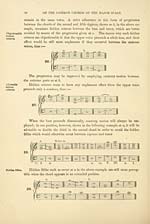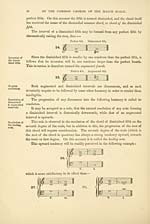Inglis Collection of printed music > Printed text > Treatise on harmony
(27) Page 19
Download files
Complete book:
Individual page:
Thumbnail gallery: Grid view | List view

OF THE OTHER COMMON CHORDS OF THE MAJOR SCALE.
19
The progression b is preferable. If however the hidden fifths are between Allowable
the middle voices, they are less objectionable.
hidden fifths.
30.
I
S
L
8L§1
■rlr
p
?=
EXEKCISES.
2.
-(=
-m-
-f=>
■JPC^L
C=£ 1
3.
^
4.
5.
S
e
&
122
1"
ez 2=2
=g
&
g
P3
a
a
^
zz
The fourth of the above exercises will require some little explanation. It Sequence,
will be observed that the progression of the bass in the first bar is repeated in
the three succeeding bars. Any such regular progression is termed a sequence,
and demands a like regularity in the progression of the accompanying voices.
This regularity could not be obtained by working exactly according to the rules
already given, thus : —
zzs£zz
32.
etc.
2=£
:<=z:
^
=^=
It will therefore be necessary to make a leap at the end of the first bar, in
order to bring the first chord of each bar into the same position, and thus preserve
the uniformity of the sequence.
-J—
33.
P
sk
i£
etc.
m
^
^=
-f=_
=£2-
A similar sequence is also contained in the first exercise of Ex. 31. It is,
however, one which can be accompanied without any deviation from rule.
In the third bar of the fourth exercise we find a chord which we have not yet chord of
considered, but which differs in many important respects from all other chords, g^^ 8
This is the chord on the seventh degree. Upon examining it we find that it is
composed of a minor third, and a fifth which is smaller by one semitone than the
19
The progression b is preferable. If however the hidden fifths are between Allowable
the middle voices, they are less objectionable.
hidden fifths.
30.
I
S
L
8L§1
■rlr
p
?=
EXEKCISES.
2.
-(=
-m-
-f=>
■JPC^L
C=£ 1
3.
^
4.
5.
S
e
&
122
1"
ez 2=2
=g
&
g
P3
a
a
^
zz
The fourth of the above exercises will require some little explanation. It Sequence,
will be observed that the progression of the bass in the first bar is repeated in
the three succeeding bars. Any such regular progression is termed a sequence,
and demands a like regularity in the progression of the accompanying voices.
This regularity could not be obtained by working exactly according to the rules
already given, thus : —
zzs£zz
32.
etc.
2=£
:<=z:
^
=^=
It will therefore be necessary to make a leap at the end of the first bar, in
order to bring the first chord of each bar into the same position, and thus preserve
the uniformity of the sequence.
-J—
33.
P
sk
i£
etc.
m
^
^=
-f=_
=£2-
A similar sequence is also contained in the first exercise of Ex. 31. It is,
however, one which can be accompanied without any deviation from rule.
In the third bar of the fourth exercise we find a chord which we have not yet chord of
considered, but which differs in many important respects from all other chords, g^^ 8
This is the chord on the seventh degree. Upon examining it we find that it is
composed of a minor third, and a fifth which is smaller by one semitone than the
Set display mode to: Large image | Transcription
Images and transcriptions on this page, including medium image downloads, may be used under the Creative Commons Attribution 4.0 International Licence unless otherwise stated. ![]()
| Special collections of printed music > Inglis Collection of printed music > Printed text > Treatise on harmony > (27) Page 19 |
|---|
| Permanent URL | https://digital.nls.uk/94714412 |
|---|
| Description | Scottish and English songs, military music and keyboard music of the 18th and 19th centuries. These items are from the collection of Alexander Wood Inglis of Glencorse (1854 to 1929). Also includes a few manuscripts, some treatises and other books on the subject. |
|---|
| Description | The Glen Collection and the Inglis Collection represent mainly 18th and 19th century Scottish music, including Scottish songs. The collections of Berlioz and Verdi collected by bibliographer Cecil Hopkinson contain contemporary and later editions of the works of the two composers Berlioz and Verdi. |
|---|

